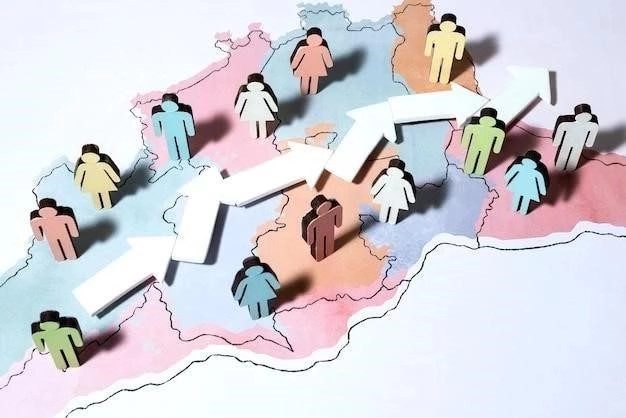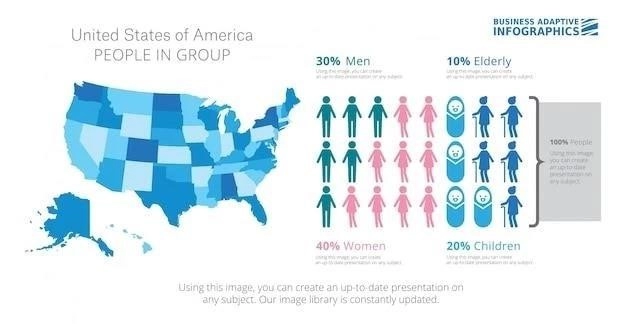Population Growth and Projections
The United States continues to experience population growth, albeit at a moderated pace. Projections from the U.S. Census Bureau indicate that the nation’s population is expected to reach approximately 404 million by 2060. This growth is primarily fueled by net immigration, which is projected to surpass natural increase (births minus deaths) as the leading driver of population expansion in the coming decades. While the rate of growth is slowing, understanding its trajectory remains crucial for anticipating future societal needs and economic demands.

Racial and Ethnic Diversity
The United States has always been a diverse nation, and recent demographic trends highlight an ongoing evolution in its racial and ethnic composition. The U.S. Census Bureau projects that by 2060, the nation will no longer have a single racial or ethnic majority. This shift is driven by a combination of factors, including immigration patterns, differential fertility rates, and the increasing frequency of interracial and interethnic partnerships.
The Hispanic population, currently the largest minority group in the U.S., is projected to experience significant growth. Meanwhile, the Asian American population is also on the rise, fueled by immigration from various parts of Asia. The Black or African American population is projected to remain relatively stable in its proportion of the total population, while the White population is anticipated to decrease as a share of the overall population.
This increasing racial and ethnic diversity has profound implications for American society. It presents both opportunities and challenges, shaping the nation’s cultural landscape, economic dynamics, and social fabric. Understanding these demographic shifts is crucial for fostering inclusivity, addressing potential disparities, and harnessing the strengths of a multicultural society.

Age Structure and Aging Population
The United States, like many developed nations, is experiencing a significant demographic shift towards an older population. This aging trend is driven by increasing life expectancy and declining fertility rates. The Baby Boomer generation, born between 1946 and 1964, is transitioning into older adulthood, contributing to a surge in the median age of the U.S. population.
This demographic transition has profound implications for various sectors of society. The healthcare system faces increasing demands as the elderly population, typically requiring more medical care, grows. Social Security and Medicare, programs designed to support older Americans, face sustainability challenges as the ratio of working-age individuals to retirees shrinks.
Furthermore, the aging workforce presents both opportunities and challenges. While the experience and knowledge of older workers are valuable assets, businesses and policymakers must adapt to their evolving needs and promote policies that support longer working lives. Addressing the multifaceted implications of an aging population is crucial for ensuring economic prosperity and social well-being in the years to come.

Geographic Distribution and Migration Patterns
The geographic distribution of the U.S. population is in constant flux, shaped by evolving economic opportunities, changing lifestyles, and individual preferences. Recent decades have witnessed significant migration patterns, including a shift towards the Sun Belt states and a resurgence of growth in urban centers.
The South and West have experienced substantial population gains, driven by factors such as job growth, lower housing costs, and warmer climates. This southward and westward migration has led to increased political and economic influence for these regions. Conversely, the Northeast and Midwest have experienced slower population growth, reflecting trends in industrial restructuring and demographic shifts.
Furthermore, urbanization continues to shape demographic patterns, with cities attracting young professionals and experiencing renewed growth. This urban revival is driven by factors such as job opportunities, cultural amenities, and a desire for walkable neighborhoods. Understanding these evolving geographic and migration patterns is essential for policymakers, businesses, and urban planners seeking to adapt to the changing needs and preferences of the U.S. population.

Immigration’s Impact on Demographics
Immigration has been a defining feature of the United States throughout its history, shaping its demographic landscape, cultural tapestry, and economic vitality. The impact of immigration on U.S. demographics is multifaceted, influencing population growth, racial and ethnic diversity, and the age structure of the nation.
Immigration is a key driver of population growth in the United States, offsetting declining fertility rates and an aging population. Newcomers arrive from diverse corners of the globe, enriching the nation’s cultural fabric and contributing to its economic dynamism. The influx of immigrants and their descendants has significantly increased the size of racial and ethnic minority groups in the U.S., contributing to the nation’s growing diversity.
Furthermore, immigrants often arrive at younger ages, starting families and contributing to a younger workforce. This injection of youthfulness helps mitigate the economic and social challenges associated with an aging population. Understanding the multifaceted impact of immigration is crucial for crafting comprehensive immigration policies that address the needs of both newcomers and established communities.
Urbanization and Suburbanization Trends
The United States continues to experience dynamic shifts in its urban and suburban landscapes, reflecting evolving demographic preferences, economic opportunities, and lifestyle choices. Urbanization, characterized by the concentration of population in urban centers, has gained momentum in recent decades, reversing previous trends of suburban sprawl.
Cities are attracting young professionals, empty nesters, and immigrants, drawn by job markets, cultural amenities, and a desire for walkable neighborhoods with access to public transportation. This urban revival has spurred revitalization efforts in many cities, leading to increased housing density, revitalized public spaces, and a renewed focus on sustainable urban planning.
Simultaneously, suburbs are evolving, becoming more diverse and experiencing their own set of challenges and opportunities. As the original suburban populations age, communities grapple with issues of aging infrastructure, changing housing needs, and the need to attract younger residents. Understanding the interplay between urbanization and suburbanization trends is essential for fostering balanced regional development, promoting sustainable growth, and addressing the diverse needs of evolving communities.

Household and Family Structures
The American household and family structure is undergoing a period of significant transformation, reflecting evolving social norms, economic realities, and individual choices. The traditional nuclear family structure, consisting of two married parents and their children, is becoming less prevalent, giving rise to a wider array of diverse household arrangements.
The rise of single-parent households, cohabitation, same-sex marriage, and delayed marriage has reshaped the conventional notion of family. Furthermore, the increasing prevalence of individuals living alone, driven by factors such as career aspirations, financial independence, and personal preferences, is also contributing to this diversification of household types.
These shifts in household and family structures have profound implications for various social and economic domains. Policymakers and service providers must adapt to the changing needs of diverse families, addressing issues such as childcare, parental leave, and support systems for non-traditional families. Understanding these evolving dynamics is crucial for fostering inclusive policies and creating communities that support the well-being of all individuals and families.

Educational Attainment
Educational attainment in the United States exhibits a dynamic interplay of progress and persistent disparities. The nation has made significant strides in increasing overall educational levels, but disparities across racial, ethnic, and socioeconomic groups continue to pose challenges. A more educated workforce is essential for driving innovation, economic competitiveness, and civic engagement in the 21st century.
The proportion of Americans with a high school diploma or higher has steadily increased over the past few decades. However, significant gaps remain between different demographic groups. For instance, while the college graduation rates for Asian Americans and Whites have risen, those for Black and Hispanic Americans lag behind, reflecting systemic barriers to educational opportunity.
Addressing these disparities is crucial for creating a more equitable and prosperous society. Policies aimed at expanding access to quality early childhood education, providing affordable college tuition, and supporting under-resourced schools are essential for ensuring that all Americans have an equal opportunity to achieve their full potential.
Economic Implications of Demographic Shifts
The evolving demographics of the United States have profound implications for the nation’s economic landscape, impacting workforce dynamics, consumer markets, and overall economic growth. Understanding these demographic shifts is crucial for policymakers, businesses, and individuals alike to adapt to the changing economic realities.
An aging population presents both opportunities and challenges. The growing cohort of older adults represents a significant consumer market, with specific needs and preferences. However, an aging workforce also presents challenges, such as a potential shortage of skilled labor and increased pressure on social safety net programs like Social Security and Medicare.
Furthermore, increasing racial and ethnic diversity brings both economic dynamism and the need for inclusive policies. A diverse workforce fosters innovation and expands consumer markets. However, addressing persistent economic disparities across racial and ethnic groups is crucial for ensuring equitable economic opportunities for all Americans. Adapting to these demographic shifts through targeted policies, workforce development initiatives, and inclusive economic strategies will be essential for sustained economic growth and prosperity in the 21st century.
Healthcare Challenges and Opportunities
The shifting demographics of the United States present a complex interplay of challenges and opportunities for the nation’s healthcare system. An aging population, increasing diversity, and evolving disease patterns necessitate innovative approaches to healthcare delivery, financing, and access.
The growing elderly population, while living longer, experiences higher rates of chronic illnesses, requiring more complex and long-term care. This demographic shift places significant strain on healthcare resources and necessitates a greater focus on geriatric care, preventive medicine, and the management of chronic conditions. Additionally, the increasing racial and ethnic diversity underscores the importance of culturally competent healthcare, addressing disparities in health outcomes, and ensuring equitable access to quality care.
Simultaneously, advancements in medical technology, data analytics, and telehealth offer promising avenues for improving care coordination, enhancing disease prevention, and expanding access to underserved populations. Effectively navigating these challenges and capitalizing on emerging opportunities will be paramount to ensuring a sustainable and equitable healthcare system for a demographically diverse nation.

Political and Social Consequences
The evolving demographics of the United States have profound and far-reaching political and social consequences, shaping the nation’s political landscape, social fabric, and national identity. Understanding these demographic shifts is crucial for navigating the complexities of a rapidly changing society and fostering a more inclusive and equitable nation.
The growth of racial and ethnic minority populations is transforming the electorate, increasing the diversity of voices and perspectives in the political arena. This demographic shift has implications for political representation, voting patterns, and the prioritization of policy issues. Additionally, the aging of the U.S. population raises questions about intergenerational equity, the sustainability of social safety net programs, and the political priorities of an older electorate.
Moreover, these demographic shifts can exacerbate existing social divisions or create new ones, particularly if economic disparities persist across racial, ethnic, and generational lines. Addressing these challenges through inclusive policies, open dialogue, and a commitment to social justice is essential for fostering social cohesion and harnessing the strengths of a diverse society.
Future Demographic Trends and Predictions
Projecting future demographic trends is inherently complex, yet crucial for anticipating the challenges and opportunities that lie ahead for the United States. While demographic shifts are subject to various influences, current projections offer valuable insights into the potential trajectory of the nation’s population.
The U.S. population is projected to continue growing, albeit at a slower pace, driven primarily by immigration. The nation is projected to become more racially and ethnically diverse, with no single group constituting a majority by the middle of the century. The aging of the population is expected to continue, with significant implications for healthcare, social security, and the workforce.
Furthermore, urbanization trends are likely to persist, with cities continuing to attract residents and investment. Understanding these projected demographic shifts is essential for informing policy decisions, guiding business strategies, and fostering a society equipped to navigate the complexities of a changing nation. By proactively addressing the challenges and harnessing the opportunities presented by these demographic trends, the United States can chart a course toward a more prosperous and equitable future.
Policy Implications and Responses
The dynamic demographic shifts occurring in the United States necessitate thoughtful and comprehensive policy responses to address the multifaceted challenges and harness the emerging opportunities. Policymakers at all levels of government must engage in proactive and data-driven decision-making to ensure a prosperous and equitable future for all Americans.
Addressing the needs of an aging population requires reforming social safety net programs like Social Security and Medicare to ensure their long-term sustainability. Investing in geriatric care, promoting healthy aging initiatives, and creating age-friendly communities are also crucial. Furthermore, fostering economic opportunities for a diverse population necessitates tackling persistent disparities in education, employment, and healthcare access.
Policymakers should prioritize investments in early childhood education, affordable higher education, and workforce development programs tailored to the needs of a changing economy. Immigration reform that promotes integration, strengthens border security, and addresses the root causes of migration is also essential for harnessing the economic and social contributions of immigrants. By enacting comprehensive and forward-looking policies, the nation can effectively navigate the challenges and opportunities presented by its changing demographics, ensuring a brighter future for all.










